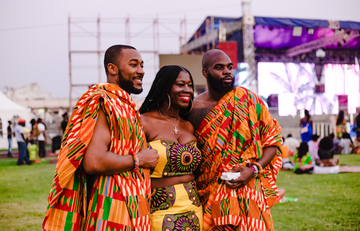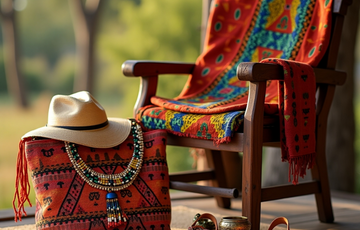Step into the world of West Africa, where vibrant African prints have mesmerised global fashion and become a staple for various occasions. Among them, Ghanaian Kente fabric stands out with its captivating patterns and harmonious fusion of colours. A Kente fabric is a failsafe choice, effortlessly elevating any everyday outfit.
The Origins of Kente Fabric
Originating from the Ashanti Kingdom in Ghana during the 17th century, Kente fabric holds a legendary tale. Inspired by a spider weaving its intricate web, two Ashanti weavers, Krugu Amoaya and Watah Kraban, created the first Kente cloth. Initially reserved for Ashanti royalty and nobility, this fabric became a symbol of wealth, status, and prestige.
Evolution and Global Influence
Over time, the production of Kente cloth spread to other ethnic groups in Ghana, gaining popularity across Africa and around the world, embraced by African-American and Caribbean communities alike.
The Meticulous Weaving Process
Crafting Kente fabric involves a labour-intensive narrow-strip weaving technique. Individual strips of cloth, measuring 6-10 inches, are meticulously woven together to form a larger piece of fabric. This intricate process demands exceptional skill and patience.
Starting with raw cotton or silk fibres, artisans spin them into yarn, which is then dyed using natural plant-based dyes like indigo and kola nut, resulting in the vibrant colours that define Kente fabric. Hand-weaving the dyed yarn on a loom, weavers intricately pass the shuttle over and under the warp threads, creating mesmerising patterns. Each cloth strip is typically four inches wide and can vary in length.

A man using a handloom to make Kente Fabric.
source:tdsblog.com
Symbolic Colours and Their Meanings
Kente fabric's diverse colour palette carries profound symbolism: Gold signifies status and serenity, Yellow represents fertility, Green symbolises renewal, Blue embodies pure spirit and harmony, Red signifies passion, Black represents union with ancestors, Grey signifies cleansing rituals, Maroon represents the colour of mother earth, Pink or Purple represents the feminine aspect of life, Silver signifies serenity, and White symbolises purification and festive occasions.
A Collection of Kente Fabrics .
Preserving Tradition: From Artisans to the Global Market
While Kente production has expanded, transitioning from traditional weavers to large fashion brands or even manufacturers overseas, the fabric's popularity remains steadfast. However, it is crucial to support artisans who preserve the authenticity and traditional craftsmanship of Kente fabric.
Cultural Significance and Beyond
Beyond its ceremonial use, Kente fabric holds immense cultural significance and serves as a representation of African heritage. Ashanti royals and paramount chiefs adorned it, and today it is worn during special occasions such as weddings, funerals, and religious ceremonies. Furthermore, Kente fabric has become a symbol of African pride and identity, connecting people of African descent worldwide to their cultural roots.
A Kaleidoscope of Kente Creations
Kente fabric finds its way into various creations, from clothing and accessories to home decor. Adorn yourself with vibrant dresses, skirts, bags, purses, scarves, and shawls made from Kente fabric. You can even find Kente-inspired jewellery and stunning wooden carvings showcasing the fabric's intricate designs.

A collection of kente fabrics
Explore the World of Kente
Experience the allure of Kente fabric by exploring the exquisite collection of clothing, accessories, and home decor available at Mawu Africa and immerse yourself in the richness of West African heritage.





